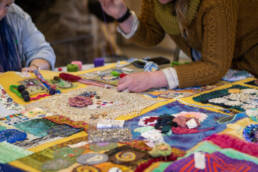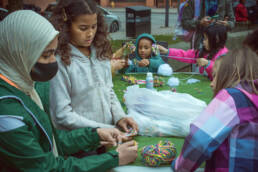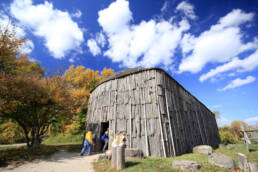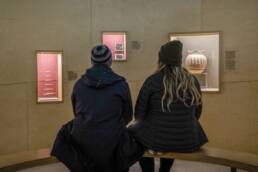Photo: Sandra Oh in “Last Night” by Don Mckeller
Dave Dyment has created several works investigating cinematic representation. In the following blog he reflects on the representation of Toronto in films.
Film critic Roger Ebert was once asked on a talk show if he could define the difference between American and Canadian films. He said that he could not. Wayne Clarkson, the former director of the Toronto International Film Festival, interjected, confident that he could:
“[In Last Night] Sandra Oh goes into a grocery store to find a bottle of wine for dinner. The store has been looted, but she finds two bottles still on the shelf. She takes them down, evaluates them, chooses one, and puts the other one politely back on the shelf. That’s how you know it’s a Canadian film.”
An abandoned and later over-turned streetcar in Don McKellar’s Last Night helps identify the film’s setting as distinctly Toronto. Apart from a few ‘legacy’ lines upgraded to light rail, most North American streetcar tracks were removed after World War II. Only Toronto continues to operate a substantial streetcar network.
When Last Night was released in France, the poster image of Sandra Oh in front of a streetcar caused the distributors to balk. “Oh, we can’t have this,” they said. “Why not?” McKellar asked.“We want it to look like North America,” they replied. “This looks like Poland.”
I saw the film with a friend in Toronto, and when we stepped out of the Carleton cinema there was also an abandoned streetcar on College street, right in front of the theatre. We had a longstanding date to see a New Year’s Day matinee together, to basically have the cinema to ourselves. This was January 1st, 1999, one of the coldest days of the year, the day before a snowstorm incapacitated the city and mayor Mel Lastman called in the army for assistance.[1] The streets were desolate – very few cars and not a single other pedestrian. There was no driver in the streetcar, no passengers. We ran a few doors down to a cafe at the corner of Yonge and College. The place was mostly empty and a complete mess, which was initially jarring. Then I found myself rationalizing “Well, of course they haven’t bussed the tables, it’s the end of the world.”[2]
A couple of years prior I had seen the trailer for Independence Day in which a spacecraft casts a shadow over Washington and its various monuments, eventually coming to hover over the White House. Very briefly I thought that this could be a fantastic film. If it took place in the time between the spaceship arriving, and contact. No action sequences, just a possible existential threat hovering from above. Would we go to work? Would we still send our children to school?
Of course, a second later the ship fires on the White House and obliterates it, followed by scenes of the Empire State Building and Capitol Hill exploding. I’ve never seen the movie, but I gather it ends with the President flying a fighter jet and deploying a computer virus, with the aliens conveniently using the same computer operating system as us. [3]
Last Night is the film I hoped for from that trailer. It’s an end of the world account that follows a disparate group of people filling their final six hours. There is no attempt to stop the forces that are bringing about oblivion, which are not even identified. The film, rather, focuses on those who have already come to terms with their impending death.
“The movies Americans make on the subject are all about the man who is going to stop it – Bruce Willis or someone,” McKellar told author Katherine Monk. “But I was also thinking about what makes a Canadian movie Canadian, and what would the Canadian response be?”
I think of Last Night as the quintessential Toronto film, but the city is not overtly featured. It is certainly not the love letter to Toronto that Sarah Polley’s 2011 Take This Waltz was. Polley (who portrays McKellar’s sister in Last Night) told Vulture magazine “I haven’t made a conscious effort to make my films feel overly Canadian, but they feel that way because I haven’t disguised what they are. We’re so used to seeing where we live disguised and meant to look like the States, that the second you don’t do that it seems like you’re being overly nationalistic.”
She recounts a story of an agent in Los Angeles telling her that the story could be so much bigger if it were based in New York. “I thought it was so funny; like, you can’t have a film set anywhere else and have it be universal? The more a film is specific about where it is, the more the universality of the story resonates, I think. [4] I really wanted to capture Toronto as I see it, which is a slightly utopian version.”
Toronto is a character in Take this Waltz, the way that Berlin is a character in Wings of Desire, New York City in Taxi Driver, Rome in La Dolce Vita, Paris in Cleo from 5 to 7, etc. etc. I don’t think of Toronto functioning in a similar way in Last Night. McKellar eschews skylines, we never see the CN Tower and much of the exterior shots were filmed in North Toronto, far from Downtown and recognizable landmarks.
“Toronto is actually a tough city to represent visually, because it’s so varied,” McKellar told Now Magazine.“It doesn’t have an overriding distinctive look like Montreal does, and a lot of cities do. And of course that’s been good for foreign films shooting here, wanting it to be Hanoi or whatever they want it to be. But it’s hard sometimes to find the Toronto character.”
But like Polley, McKellar was interested in a utopia, of sorts. He opted for mid-century modern interiors, the governmental offices of Macdonald Block [5], and the sculptural apartment buildings designed by Estonian architect Uno Prii. The idea of an “outdated future” meshes perfectly with the plot: “I wanted this feeling of dashed aspirations of 20th century optimism that you can find in a certain kind of Toronto architecture”.
“Toronto never plays Toronto,” McKellar told the Irish Times in 1999. “In Toronto we never have our own streets named as what they are. The city is a huge production centre and it plays every American city – Chicago in The Blues Brothers, Boston in Good Will Hunting and New York in so many films. When I showed Last Night at the Toronto Film Festival there were actually gasps in the audience at the locations being identified for what they are.”
Four years later Deepa Mehta’s musical romantic comedy Bollywood/Hollywood debuted at TIFF and audiences once again gasped, this time at the site of the CN Tower. It remains jarring, as we are entirely accustomed to seeing our city masquerading, even in local productions.
I was once staying with a friend in New York City and she was watching an early Woody Allen film on television while I was looking out the window. Her apartment was across the street from a health centre with distinctive architecture and at one point I glanced at the TV and saw an establishing shot of the building in the film, then turned my head back to confirm. I pointed this out to her and she seemed entirely indifferent. She didn’t find it notable in the least, even to share with a tourist. Toronto gasps, New York shrugs. New York is a film star, Toronto a stunt double.
Perhaps the most quintessentially Canadian aspect of Last Night is the way it satirizes the stereotype of the passive and polite Torontonian, and investigates questions of civic responsibility, and etiquette.
If couples find it difficult to navigate time with both of their families at Christmas, how much more complicated would that become if Christmas dinner were held on the last night on earth? The family of McKellar’s character Patrick host one final Christmas meal, despite the fact that it’s not Christmas. Patrick shows up late and doubly offends his parents by opting to leave early, also, to spend his final moments alone.
His sister’s boyfriend shares a moment of sympathy for the rioters, who are just “blowing off steam” in the face of their inevitable annihilation. Patrick’s father indignantly announces “That gives us all the more reason to be civil. Now more than ever we should be courteous and respect each other’s needs.”
Footnotes:
- The inevitable jokes about Toronto not being able to handle a little snow continued for years.
- Another apocalyptic film provided the only other instance of this blurring of fact and fiction that I’ve experienced to this degree: I saw 28 Days Later at a drive-in with an almost empty tank of gas. It was three days into the Northeast Blackout of 2003, and while some power had returned, most gas stations were not yet open. As the characters in the film rationed and struggled to survive we had to juggle periodically starting the car (depleting our already low gas supply) or risk draining the battery, given that the film’s audio played over the radio. I remember planning a route home where the last person we dropped off lived atop a hill, thinking we might be able to coast the final few miles.
- To juxtapose this, I am pretty sure the site we are going to watch Last Night on together will only function with Chrome or Firefox, not Safari.
- Terry Gilliam once described a dispute with an executive who argued against including specific location information in a Monty Python script, as it would alienate the broader audience. He argued that it would have the opposite response, that it could pique the curiosity of the viewer. He cited the Beatles’ single Penny Lane/Strawberry Fields Forever, both about very specific small places in Liverpool that became an instant international classic.
- When the MacDonald Block was being constructed, it was the filming location for Buster Keaton’s final film,The Scribe. The 30 minute short – produced by the Construction Safety Association of Ontario to promote site safety – was released on May 1st, 1966. Keaton died of lung cancer exactly three months prior, at the age of 70.
For a full list of Dave Dyment’s recommended readings and films, click here.
You can check out our full list of Special Programs here.
Related Articles
Indigenous Arts Culture Organizations to Support
Indigenous History Month is a time to honour the rich cultural diversity of Indigenous people across Canada. As a resource, we have highlighted a few of many Indigenous arts and culture organizations that operate within Ontario.
Press Release: ONTARIO CULTURE DAYS ANNOUNCE EIGHT NEW CREATIVES IN RESIDENCE PLUS A THEME FOR THE 2024 SERIES
Ontario Culture Days has announced the thirteen Ontario communities selected to be official 2024 Festival Hubs for the fall festival.
Looking Back at 2023 Creatives in Residence
In 2023, Creatives in Residence artists explored the theme of material culture with local workshops, installations, and performances.
Outreach Assistant
Reporting to the Marketing Manager, the Marketing and Communications Associate, Northern Ontario will play an integral role in increasing the impact of the 2024 Ontario Culture Days Festival in Northern Regions.
Plan your Spring Outdoor Adventure in Ontario
Looking to enjoy Ontario’s spring weather? Plan an outdoor adventure and explore the province while you enjoy arts, culture and history.
Brave Space, Third Space Resources
Read resources shared at the Brave Space, Third Space panel, featuring leadership of two brave spaces in the arts and culture sector.
Press Release: Ontario Culture Days Festival Hubs 2024
Ontario Culture Days has announced the thirteen Ontario communities selected to be official 2024 Festival Hubs for the fall festival.
Staff Picks for March Break Family Fun
How are you going to keep your family busy this March Break? With plenty of fun arts and culture events across Ontario, we've got you covered.
The Economic Impact of Arts and Culture Tourism
Ontario Arts Council-funded report shows that arts and culture tourism within Ontario has triple the economic impact of non-arts and culture tourism.
Links from Artificial Intelligence: Problem Solver or Chaos Maker
Thanks to all that expressed interest in this webinar. Many attendees requested a list of links from the chat, so we are sharing them!









